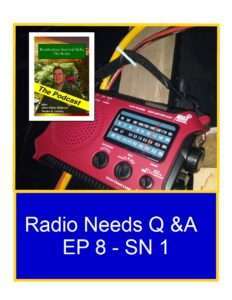#14 Radio Needs Q &A
During a recent weather event, the grid in our area was down.
7000 people without power for about eight hours or more.
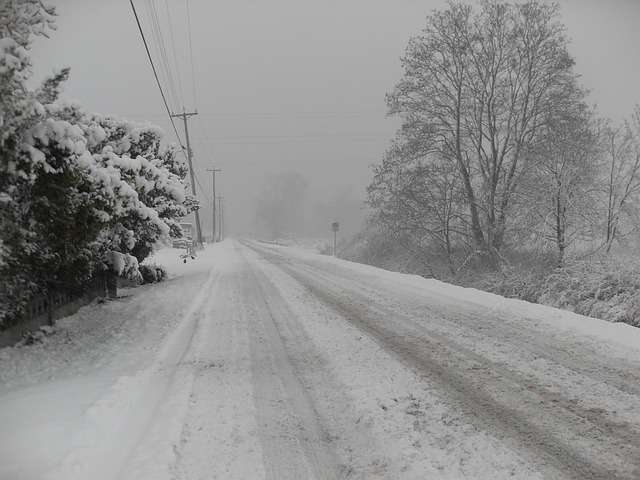
You Can Listen to the Pod Cast here.
The top priority for the people in our area was
Information:
-How long will the power be out?
-Do I need to set up the Emergency Gear?
-Do I need to go to a shelter?
-Is my home already isolated from outside services or the Grid?
Do I even care or notice that other people’s power is out?
-Cell Phones and or Internet may be down or shut down.
Other Needs – Not in any real order:
Physical Safety: Weather, War, Civil Un-rest, Medical Emergency
Heating / Cooling
Water
Lighting
Food
Cooking
Refrigeration
Medication / Medical Needs
Fuel
Back up power systems or temporary Power Systems
Two-way communication / Internet
Cell Phone Recharging
Take actions to preserve what I own or need.
These needs can vary depending on the household, health and age of
the people affected. It also depends on the disaster or Emergency each person faces.
This Blog Post will address one way communication and information gathering.
We are only talking about receivers here for emergency and general use.
Definition of radio equipment:
Radio Receiver: The Radio that you listen to your favorite FM/AM station in the car.
Radio Transmitter: the Radio that you talk on.
Radio operators, in most cases, have two radios, one for transmitting and one for receiving.
But what about something like a CB Radio?
A CB is a Radio Tran-sever: A radio that can both be used to talk on (transmitter) and listened to (receiver).
Citizen’s Band, CB Radios operate on the 11 Meter Band around 27 MHz with 40 channels. Access
to these frequencies and this band is unrestricted by the FCC. No license required.
What do we need to start with in an emergency?
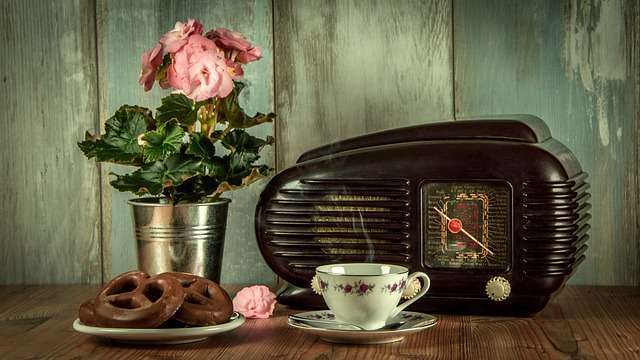
A Radio with AM, FM, WX (Weather) can provide a minimum safety net for getting information.
The WX on a radio with a weather alert radio will activate the Auto Alert Function (WX)
You must press this to automate the alert on “YOUR RADIO”.
It may be as simple as using your car or truck radio. The Problem with this is.
Lack of convenience and lack of portability. It also requires exposure to the outside regardless of safety.
No one should leave a safe shelter to go listen to the car radio or charge a cell phone in the middle of a hurricane.
If fuel is limited, your car’s gas could be put to better use.
Some of the new emergency radios can also aid in charging your cell phone.
The internal batterie can be charged multiple ways – Solar, Crank, AC/DC power supply (generator, car or power pack)
or simply by replacing batteries.
Radios can receive local news and information as well as worldwide news and information.
A weather band setting (WX) can be set to auto. One night in our yurt the radio started setting off an alarm that sounded like a burglar alarm.
It scared the heck out of us at 2AM. The alert was for high winds. It gave us time to decide what to do.
We have sustained 70 mile per hour winds with no problem. This night it was going to be 60 mile per hour winds. We rode it out and all was well.
I have lived through a micro-burst that uprooted trees and destroyed an out house while camping. It sounded like a freight train.
That came with no warning. What saved us? The micro-burst followed a creek bed and tour up a state built lean-to and out house. We were camped above.
The creek bed, in an over flow camp area that our program had helped establish. No one was hurt.
International news and information can be had with SW1 or SW2.
Each selection has to do with wave propagation and atmospheric interference.
One can also get weather fax reception (Topic for another post) without the internet or phone.
These setting will not give you the WX stations from NOOA. You will need a better radio or one with a WX setting.
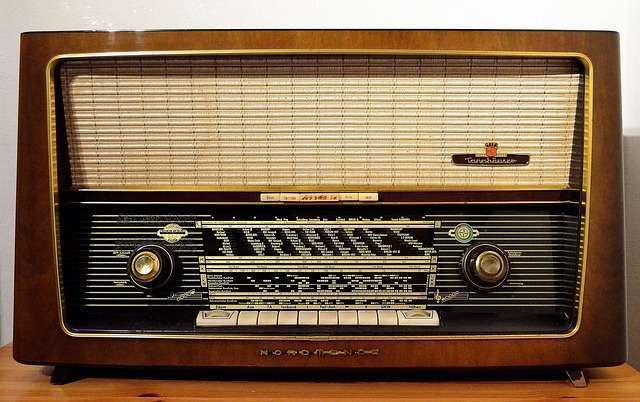
Short Wave 1 (Used During The Night Time)
Short Wave 2 (Best During the Day Time)
A little more information: Radio Channels are identified by call letters and are signed frequencies. Low to High frequencies, Ultra High and Long Wave or Very low frequencies. Some will pick up CB and other Radio Signals.
Some will not. You need to look at the range of the radio.
Also, the selectivity and sensitivity of the radio matters.
Selectivity is a measure of the performance of a
Radio receiver to respond only to the radio signal it is tuned to and reject other signals. More expensive radios are usually better at this.
Sensitivity is the minimum signal which can be detected with accepted output SNR (Signal-to-Noise Ratio)
FM signals are less susceptible to noise than A.M. signals. Most shortwave (SW) broadcasting is A.M..
AM and SW are the best place to get: talk radio, news, weather, traffic, sports and opinions.
FM will give you music and National Public Radio (NPR). NPR can be a great source of information. Some people claim it is far more
liberal (Left wing) in its reporting.
The Software-defined Radio or SDR
A Radio USB Dongle, Software-defined radio (SDR) can give you a lot of frequency or station options. The problem is it may have poor selectivity and sensitivity.
It also requires a Lap top or other device to make it work.
Multiple sources say that: “The SDR is a low-cost USB device or “Dongle” that can be used as a computer supported radio for receiving radio signals in real time.
Depending on the SDR, it can receive frequencies [from ~13 – 1864 MHz with experimental drivers]. Some of these USB “Dongles” can even be used to transmit.
I own one of the receiver models but have yet to spend any time using it. I will update this post later.
Remember, Ham Radio Operators love to experiment and many have a lot of training in electronics. Yes, I was an Electronics Tec and an IE Tec.
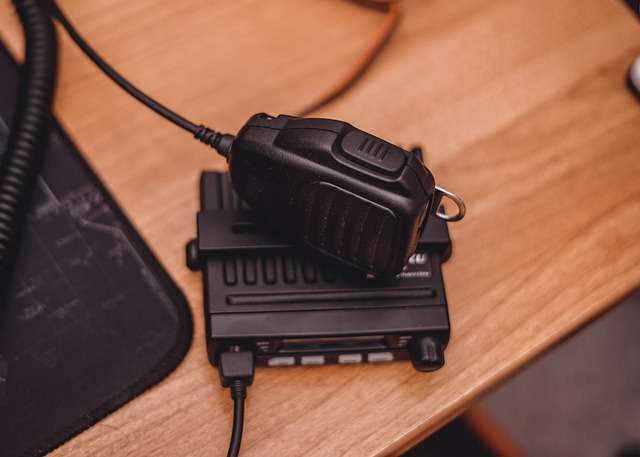
A word about SSB and BFO
This is the simple statement you need to know without getting into terms like band pass and oscillators. Still with me?
Single Side Band Radios (SSB) is used to transmitting CB and other types of radios far distances. Listening to SSB broadcasts requires you to own a receiver
that can convert the radio signal to something you can hear. CB radio is not the only group that uses SSB on its radios.
Example: Weather Fax.
BFO (Beat Frequency Oscillator) is a tuning Nob/Switch that makes the sound clearer to the listener.
I personally have a lot of radios. I also have a small DC / AC – T.V. with an antenna.
My emergency TV is digital (9″ Portable Digital LCD TV w/ USB & SD Inputs, 12 Volt AC/DC).
An old RadioShack scanner comes out on bad days or days I am just interested in listening in.
I have collected the parts for a Free-to-Air channel satellite receiver but have not installed it yet.
Yes, at one time I installed satellite dishes for a living. Have i done every job in the world NO. But it sure feels like it some times.
The name of the game is hustle and side hustle. If it doesn’t work out at least you get an education and experience.
You do not need all of this stuff. Just a good radio as stated at the beginning of this article.
One major tip: I Never buy any piece of equipment that can not be controlled if a remote is lost.
It must have controls on the unit. I opt for non digital displays and Chanel selects if possible.
If it is good quality, the digital display is just fine.
Remember, A.M. radio is scheduled to be phased out of cars and trucks by the manufacturers. Much of the best news and emergency information is on the A.M. band.
A hand crank / Battery / Solar radio kept in the glove box or
an emergency kit can be vital to your emergency gear.
I also like to keep in the car:
A Day Pack
Power Bars
Hard Candy
A Compass
A Road Atlas
3-5 candles
A Mettle coffee can
A metal cup
2 Water bottles – Stainless
1 Gal of water
2-lighters
20′ of Para Cord
A Good Pocket knife
A Blanket
Headlamp and Batteries
Crank Radio
Destress Flag (Orange 4’X4′)
Hand Chain Saw
Tarp or Military Poncho
Flat Fixer Can
Puncture Kit
12V Air Compressor
Fire Extinguisher
Car or Truck Jack and Lug Wrench (Correct Size)
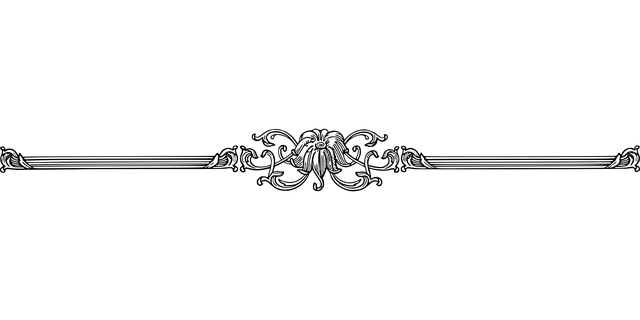
All NOAA Weather Radio stations broadcast on one of
seven frequencies in the VHF Public Service:
A weather alert radio will just show 1-7 not the MHz.
162.400 megahertz (MHz),
162.425 MHz,
162.450 MHz,
162.475 MHz,
162.500 MHz,
162.525 MHz,
162.550 MHz.
The WX on a radio with a weather alert will activate the Auto Alert Function (WX)
You must press this to automate the alert on “YOUR RADIO”.
Here is a list of some different radios:
At this time, I make nothing from this list. Many other radios will work.
The Best Radio is the one you have that works.
- Kaito KA500 5-way Powered Solar Power, Dynamo Crank, Wind Up Emergency
AM/FM/SW/NOAA Weather Alert Radio with Flashlight, Reading Lamp and Cellphone Charger
This is the radio I keep on my work table. - Midland – ER210, Emergency Compact Crank Weather AM/FM Radio – Multiple Power Sources,
SOS Emergency Flashlight, NOAA Weather Scan + Alert, & Smartphone/Tablet Charger
My Antenna did not hold up well. I like this combo radio. - Hand-Crank Eton FR300 Multi-Purpose AM/FM/TV-VHF Radio NOAA Weather Emergency
59 ( TV setting is no longer of any use – Thanks to the FCC digital conversion of T.V. broadcasting.) - My First “Good” Radio was a RadioShack SW-100 AM/FM/SW/CB/TV/Air/Weather Radio. I loved that radio.
I have since replaced it with a RadioShack Multi-Band Portable AM/FM CB TV Weather SW1 SW2 Radio Model 12-795 - PRUNUS – Pocket Radio Mini AM-FM Stereo Radio Portable Battery Operated Radio. (Ordering one this month)
I still have and use my RadioShack Mini AM / FM Radio. The problem with these is that if your ear buds fail, then the radio becomes useless.
It takes one AAA battery. Speakers take more juice to drive. My one battery radio is simple and works. - Consider any one of several small inexpensive radios with a built-in speaker.
Also, some small radios are very pricy but work really well. Sony ICF-SW7600GR AM/FM Shortwave World Bank Receiver with Single Side Band Reception
Just under $400.00 Small and the standard.
- On my Short list to test: Eton – Elite 750, The Classic AM/FM/LW/VHF/Shortwave Radio with Single Side Band, 360° Rotating AM Antenna,
1000 Channels, Back-Up Battery Packs
Big Price Big Radio
